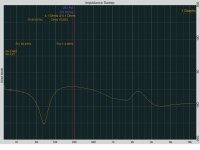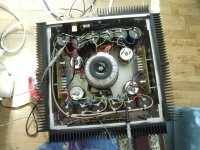Hello Pass Labs community. I have a nearly finished Aleph 4 100 watts (48 volts rails) monoblock project which I am reluctant to finish because of my 4 ohm nominal impedance speakers.
I am planning on using the aleph on my speakers from above 120 hz since I have subwoofers which will be tackling the rest of the sub 120 hz area. Anyway it is still a pretty low impedance and I wonder whether this layout without the bass frequencies will make it somewhat easier to manage for the Aleph. It is a D'appolito two way system with two Seas L17 REX/P midbass driver and one Aurum Cantus G2Si circular ribbon tweeter.
I have measured the speakers and the lowest impedance is at 230 hz with 4.1 ohms. It is pretty flat, rising steadily to 9 ohms at just before the crossover frequency at 2600 hz.
Impedance graph is attached.
Any tips and suggestion concerning this is highly appreciated. Real life accounts of similar setups is of course of best value for me. Thanks in advance!
Regards Rick, Oslo Norway
I am planning on using the aleph on my speakers from above 120 hz since I have subwoofers which will be tackling the rest of the sub 120 hz area. Anyway it is still a pretty low impedance and I wonder whether this layout without the bass frequencies will make it somewhat easier to manage for the Aleph. It is a D'appolito two way system with two Seas L17 REX/P midbass driver and one Aurum Cantus G2Si circular ribbon tweeter.
I have measured the speakers and the lowest impedance is at 230 hz with 4.1 ohms. It is pretty flat, rising steadily to 9 ohms at just before the crossover frequency at 2600 hz.
Impedance graph is attached.
Any tips and suggestion concerning this is highly appreciated. Real life accounts of similar setups is of course of best value for me. Thanks in advance!
Regards Rick, Oslo Norway
Attachments
An aleph 4 will drive 4ohm speakers with authority, power, and control. There will be no lack of bass or bass control. There is no reason to think that the amplifier will have any difficulty at all. The aleph circuit is almost universally stable into any speaker load.
As 6L6 already stated there is no chance of damaging the Aleph and if they are nearly finished then you should definitely proceed. I recently finished a set of Aleph mono's (thread here) and I would recommend you not make a decision on their sound quality with your speakers until they have had at least 50 - 60 hours of operation time. My Aleph's sounded a bit congested in the upper frequencies initially, but the sound opened up considerably after about 50 hours of run time.
4 ohm depends on how many watts you want and how much bias.
If you have enough supply and heat sinking to support a high bias current,
then it will work great.
Otherwise, think monoblocks.
😎
If you have enough supply and heat sinking to support a high bias current,
then it will work great.
Otherwise, think monoblocks.
😎
Actually it is monoblocks! They are supposed to deliver 100 watts at 8 ohms. I was wrong about the voltage rails. They are 2x 38 volts. The coils are 2x 150 V of which I have two, so 600 volts per channel. Caps are 22x8200 uf 63 volt=180400 uf per channel.
I am not an engineer, but maybe some of you guys can comment on whether this is adequate concerning my speakers? I am planning on building a rather large cabinet with massive heatsinks on each side. The sinks are 400 mm deep and 266 mm high. I will use only aluminium for the rest of the cabinet.
I am not an engineer, but maybe some of you guys can comment on whether this is adequate concerning my speakers? I am planning on building a rather large cabinet with massive heatsinks on each side. The sinks are 400 mm deep and 266 mm high. I will use only aluminium for the rest of the cabinet.
Actually it is monoblocks! They are supposed to deliver 100 watts at 8 ohms. I was wrong about the voltage rails. They are 2x 38 volts. The coils are 2x 150 V of which I have two, so 600 volts per channel. Caps are 22x8200 uf 63 volt=180400 uf per channel.
I am not an engineer, but maybe some of you guys can comment on whether this is adequate concerning my speakers? I am planning on building a rather large cabinet with massive heatsinks on each side. The sinks are 400 mm deep and 266 mm high. I will use only aluminium for the rest of the cabinet.
Are your transformers 2 X 38V or is that the actual DC rail voltage? I know you said that the rails are 38V but your language of "2 X 38" sounds more like the transformers output rating.
If 38V is the actual rail voltage that is a substantially lower rail voltage than the original Aleph 4 so if you bought enough heatsinking for the A4 then you will really be able to turn up the bias in your amplifier. The physical heatsink sizes you are posting don't do much good, do you have the thermal specs of your heatsinks? If you do have the specs then it should be fairly easy to approximate how much bias current you can run with the 38V rails.
Last edited:
I am refering to the transformers output. I have tried to locate specs for the heatsinks without success. They are called Fischer SK 93 265.9 SA-SL. They were bought back in 2004 from a Norwegian supplyer. If i recall correct they were quite expensive, around 450 US dollars for all 4.
Looks a bit mean to me
These beasts ROAST.
OK this is a dual mono-block. You might recognise the photo.
These beasts ROAST.
OK this is a dual mono-block. You might recognise the photo.
Attachments
Last edited:
I am refering to the transformers output. I have tried to locate specs for the heatsinks without success. They are called Fischer SK 93 265.9 SA-SL. They were bought back in 2004 from a Norwegian supplyer. If i recall correct they were quite expensive, around 450 US dollars for all 4.
I found your heat sinks here.
Based on the chart given it looks like a 3" length of your heat sink has a thermal resistance of approximately 0.43 C/W. Using the Aavid thermalloy length correction factor chart your 10" length of this heatsink has a thermal resistance of approximately 0.25 C/W. So two of them would be 0.125 C/W in a mono chassis. With the Aleph 4 you have 250 Watts per channel of heat to dissipate so you would end up with a best case 31.25 C temp rise. Realistically you will likely end up closer to 35 C temp rise.
You will not be able to adjust the bias higher than the stock Aleph 4 if your DC rails are the same 48VDC as the stock A4, unless you are willing to live with the higher temps and the subsequent higher risk of component failure.
Since the cabinet is not finished yet I am thinking about large fans which can blow out the hot air. I have a couple of Noctua fans from a stationary computer I bought two years ago. They are pretty quiet and large so they should be able to blow hot air out quite effectively. Have anyone tried this route?
Fans?? Yes many people have used them. You could put one of them blowing into or exhausting the case interior and that would help greatly. It would be better to have a fan blowing directly into each heatsink. You would be able to massively increase the bias if you used a fan mounted directly on the heatsinks. In that case I would use one of the large 200mm computer fans that spins very slowly and is almost inaudible.
There is a circuit floating around here on a thread somewhere for a simple fan control that gives a starting pulse of higher voltage to get the fan started and then drops the voltage to a lower level to keep the fan noise at a minimum. I have considered using it on some of my cases.
There is a circuit floating around here on a thread somewhere for a simple fan control that gives a starting pulse of higher voltage to get the fan started and then drops the voltage to a lower level to keep the fan noise at a minimum. I have considered using it on some of my cases.
- Status
- Not open for further replies.
- Home
- Amplifiers
- Pass Labs
- Aleph 4 monoblocks with 4 ohm load speakers?


